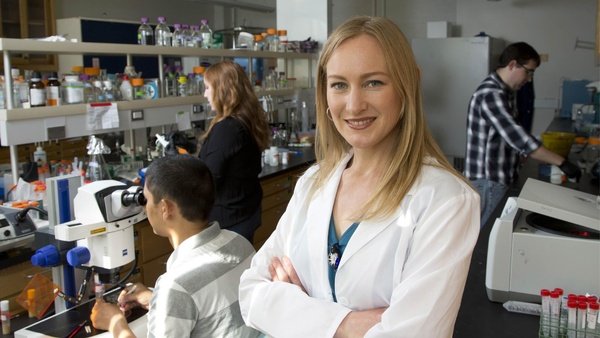Migraine Research Development Attracts National Attention
May 3, 2013

A new development in Dr. Emily Bates’ migraine research may change the future of migraine medicine and has attracted the attention of national news.
National Public Radio interviewed Dr. Bates for a news slot in its award-winning show, “All Things Considered,” which aired Wednesday, May 1. Local television news stations includingKUTV Channel Two, Fox 13 and ABC4 also covered the story.
With a team of researchers from around the country, Dr. Bates recently determined that a missense mutation in a single, specific gene results in migraines. The mutation reduces activity of an enzyme called casein kinase 1δ, altering the gene’s control of circadian rhythms (in layman’s terms, your biological clock) and making people more susceptible to migraines. The discovery suggests a link between the tendency to get migraines and advanced sleep phase syndrome, which is characterized by having a really unusual sleeping schedule, such as being unable to stay awake past 7 p.m. or sleep past 3 a.m.
The discovery represents years of work and has been long in coming – especially for Dr. Bates personally.
“My own migraines were my motivation for going into science,” she said. “I decided in high school that I wanted to understand the disorder that robbed me of my days and was beyond my control. No medication could help, so I wanted to be part of the research that would help.”
With that goal in mind, Dr. Bates studied biology at the University of Utah and earned a Ph.D. in genetics at Harvard Medical School. In 2006, she took a postdoctoral position in Dr. Louis Ptáček’s lab at the University of California, San Francisco. Dr. Ptáček’s group had just traced advanced sleep phase syndrome to a gene mutation while studying a family with both the sleeping disorder and dominantly inherited migraines; when Dr. Bates joined the team, she worked with mice engineered to have the same mutation.
“I joined Louis Ptáček’s laboratory … to figure out whether the mice that had the same mutation were more susceptible to migraine,” Dr. Bates explained. She worked on the project in Dr. Ptáček’s lab for two and a half years before accepting her current position and continuing her research at the BYU Department of Chemistry and Biochemistry.
Meanwhile, collaborators Andrew Charles and K. C. Brennan from the University of California, Los Angeles imaged the brain during the aura part of the migraine. Dr. Ptáček identified a second family with a mutation in the same gene.
“Together, all of this evidence is a strong case that casein kinase 1δ is involved in the pathology of migraine,” said Dr. Bates.
She and her collaborators published their findings May 1 in the journal Science Translational Medicine. As her research makes the genetic mechanisms behind migraines a little clearer, she hopes scientists will be able to use that knowledge to design better drugs to treat them.
By Jessica Henrie
Photos by Mark A. Philbrick